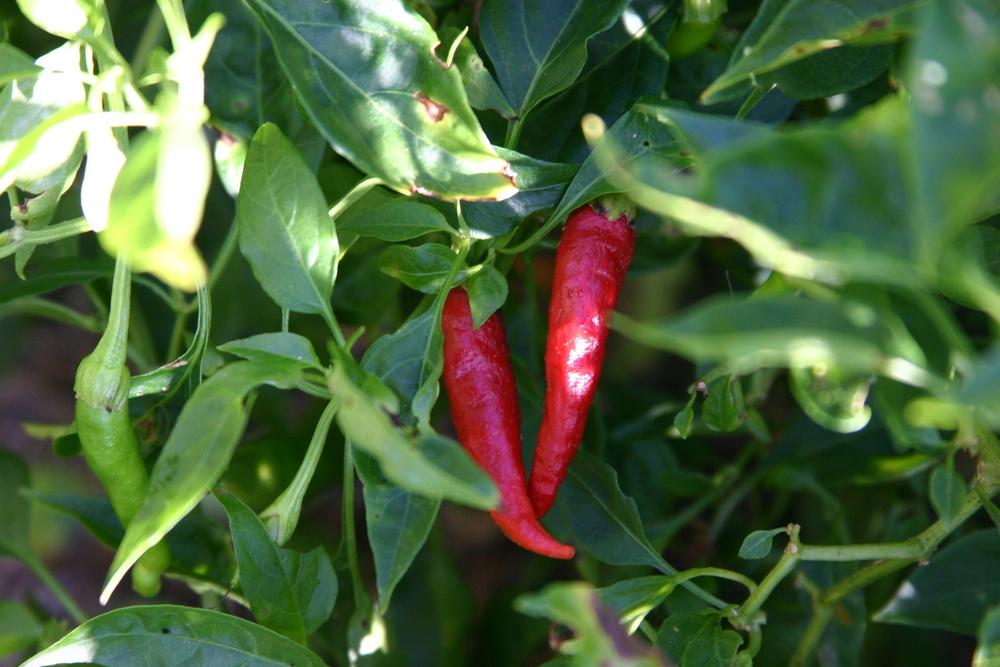
Hot Pepper Varieties
There are many different classes of hot peppers. The most popular are the jalapeno, cayenne, anaheim, habanero, and serrano classes. Hot peppers vary in "heat" from mild to very hot. Jalapenos, such as 'Tam Jalapeno', are mildly hot, featuring 3- to 4-inch-long oval-shaped fruits. Anaheims feature medium hot, elongated, blunt-ended pods measuring 4 to 10 inches long. Cayenne peppers, such as 'Super Cayenne II', are spicy, featuring slim, pointed, and slightly curved fruits, ranging in length from 2 to 8 inches. Serrano peppers have small, 2-inch-long, slim fruits and a pungent bite. For brave souls, habaneros are one of the hottest peppers available. The 1- to 2-inch-diameter 'Chinese-lantern'-looking fruits mature to orange or red and are 50 times hotter than jalapenos.
For more information on hot pepper varieties go here.
Growing Hot Peppers
Don't rush your hot pepper seedlings into the garden. Like tomatoes, they're warm-season vegetables that grow best when soil temperatures are around 60° F and all danger of frost has passed. Start seeds indoors 6 weeks before the last frost date in your area. Harden them off gradually, getting the young seedlings accustomed to the outdoor environment. As soon as the soil can be worked, build a raised bed, removing any sticks, rocks, and debris. Make the bed 3 to 4 feet wide, 8 to 10 inches tall, and as long as you like. Incorporate a shovelful of compost for each foot of bed. Rake the top of the bed flat and smooth. In northern areas consider placing black plastic or IRT mulch over the bed to heat the soil.
Hot peppers also make excellent container plants. Select a container with good drainage holes, and fill it with moistened potting soil. Keep the soil well watered and fertilized and you'll have a hot pepper factory right outside your door.
In the garden, space hot pepper transplants 1 foot apart, and wrap a cutworm collar around each seedling. The collar consists of 3-inch-diameter newspaper strips rolled around the pepper stem so the collar is 1 inch below the soil and 2 inches above it. This collar will prevent cutworms from felling your young seedlings.
Peppers are finicky about air temperatures. Temperatures below 55 ° F and above 90° F will result in fruits not setting. Keep peppers warm in early spring by placing a floating row cover over the plants. In hot summer areas, consider giving plants afternoon shade in midsummer to keep them cool.
Add supplemental balanced fertilizers, such as 5-10-10 or fish emulsion, once a month. Avoid fertilizers high in nitrogen or the pepper plant will produce lots of foliage but few fruits. For an added boost, dissolve 1 tablespoon of Epsom salts in 1 gallon of water and apply to plants at transplanting and when they begin flowering to help produce better quality fruits. Keep the peppers well weeded and watered.
A Spicy Harvest
Even though you can start harvesting peppers while they're green, for the best flavor wait until they turn yellow, orange, or red, depending on the variety. With a sharp knife, cut the pepper from the stem. The more peppers you cut, the more fruits will be produced.
When handling very hot peppers, such as habanero, use gloves and wash your hands and gloves after handling them. If you didn't get enough hot peppers during the growing season, they also can be pickled, dried, frozen, used in sauces, and canned to be enjoyed in winter.
Question of the Week
Kid-Friendly Plants
Q. I'm an elementary school teacher and want to grow some vegetables in containers with my kids this spring at the school. Can you suggest some vegetables that are especially interesting for youngsters to cultivate?
A. Some of the best vegetables to grow in containers with kids are sweet cherry tomatoes, beans, lettuce, carrots, and cucumbers. Pizza herbs (such as basil and oregano), cilantro (if they like salsa), and chives also grow well in containers and are great if you're cooking with your kids. Consider some edible flowers, such as nasturtiums, calendula, and pansies, to grow along with the vegetables. Not only will they taste good, they'll dress up the containers as well.
 Charlie Nardozzi is an award winning, nationally recognized garden writer, speaker, radio, and television personality. He has worked for more than 30 years bringing expert gardening information to home gardeners through radio, television, talks, tours, on-line, and the printed page. Charlie delights in making gardening information simple, easy, fun and accessible to everyone. He's the author of 6 books, has three radio shows in New England and a TV show. He leads Garden Tours around the world and consults with organizations and companies about gardening programs. See more about him at Gardening With Charlie.
Charlie Nardozzi is an award winning, nationally recognized garden writer, speaker, radio, and television personality. He has worked for more than 30 years bringing expert gardening information to home gardeners through radio, television, talks, tours, on-line, and the printed page. Charlie delights in making gardening information simple, easy, fun and accessible to everyone. He's the author of 6 books, has three radio shows in New England and a TV show. He leads Garden Tours around the world and consults with organizations and companies about gardening programs. See more about him at Gardening With Charlie.